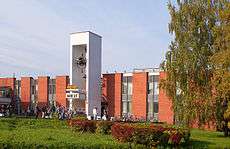National Research University of Electronic Technology
National Research University of Electronic Technology[1][2] (Russian: Национальный исследовательский университет "Московский институт электронной техники" / МИЭТ,[2] lit. National Research University "Moscow Institute of Electronic Technology"[3]) – is a Russian technical university in the field of microelectronics, information and computer technologies and one of 29 National Research Universities. University is founded in 1965 and located in Zelenograd, Moscow (the Soviet Union's center of electronic and microelectronic engineering). The university was often considered the center of the Soviet Silicon Valley.
Национальный исследовательский университет "МИЭТ" (МИЭТ) | |
 Main building of MIET | |
| Type | State |
|---|---|
| Established | December 9, 1965 |
| President | Yuri Aleksandrovich Chaplygin |
| Rector | Vladimir Aleksandrovich Bespalov |
| Students | 4259 (2015) |
| Postgraduates | 236 (2015) |
| Location | Zelenograd, Moscow , Russia 55°59′0″N 37°12′30″E |
| Website | http://www.miet.ru/ (in Russian) http://eng.miet.ru/ (in English) |
 | |
Architecture
The University complex was designed by the architects Felix Novikov and Grigory Saevich and built in 1967-1971. The complex has some similarity with the complex of the Finnish Helsinki University of Technology, built in 1954-1969 by architect Alvar Aalto. The main administrative building (#1) with library and five large lecture halls, the assembly hall (#2) with dining hall, two academic buildings (#3 and #4), and sports complex (#5) of multipurpose arena and swimming pool were built of red bricks and connected by passages in united microtown.
The decoration of the exterior walls of the library is the huge white bas-relief (970 m², all four walls) "The Becoming of a Homo sapiens" (Russian: Становление человека разумного, Stanovlenie cheloveka razumnogo) completed in 1974 by the sculptor Ernst Neizvestny.
The main facades of the main administrative building and the assembly hall are turned to Shokin's Square (Russian: Площадь Шокина, Ploshchad Shokina), named after Alexander Shokin (1909-1988), the twice Hero of Socialist Labour, the USSR Minister of Electronic Industry, one of founders of Zelenograd and MIET. The main MIET entrance is decorated by clock designed by the artist Sergey Chekhov and the sculptor Valery Tyulin and placed in the white tower. The sound system of the clock mimics striking clock (one bell stroke every 15 minutes, and X strokes of the bell at X o'clock sharp).
There is Shokin's bust in the park near the square. There are also Skokin's and Presnukhin's (the first rector) memorial plates respectively on the right and left sides of the main administrative building facade (if we are looking on the facade).
Institutes and departments
- Institute of Biomedical Systems
- Institute of Linguistic and Pedagogical Education
- Institute of Microdevices and Control Systems
- Institute of Military Training
- Institute of Nano- and Microsystem Engineering
- Institute of Advanced Materials and Technologies
- Department of Applied Information Technologies
- Department of Design
- Department (Institute) of Economics, Management and Law
- Department of Education for Foreign Citizens
- Department of Electronics and Computer Technologies
- Department of Microdevices and Technical Cybernetics
- Department of Remote Education
Rectors
- Leonid Viktorovich Ershov – 1966 (acting)
- Leonid Nikolaevich Presnukhin – 1966–88
- Vitali Dmitrievich Verner – 1988–98
- Yuri Aleksandrovich Chaplygin – 1998–2016
- Vladimir Aleksandrovich Bespalov – 2016–...
Notes
The university can be also referred to as Moscow Institute of Electronic Engineering in the English language sources, which was its English official name in the 1990s.
See also
- Moscow Institute of Electronics and Mathematics, another Russian technical institute founded in 1960s within the scope of the Soviet microelectronics program
References
- English official name for international usage.
- Contact information and Charter of MIET (in Russian)
- Direct translation of Russian official name.
External links
| Wikimedia Commons has media related to National Research University of Electronic Technology. |